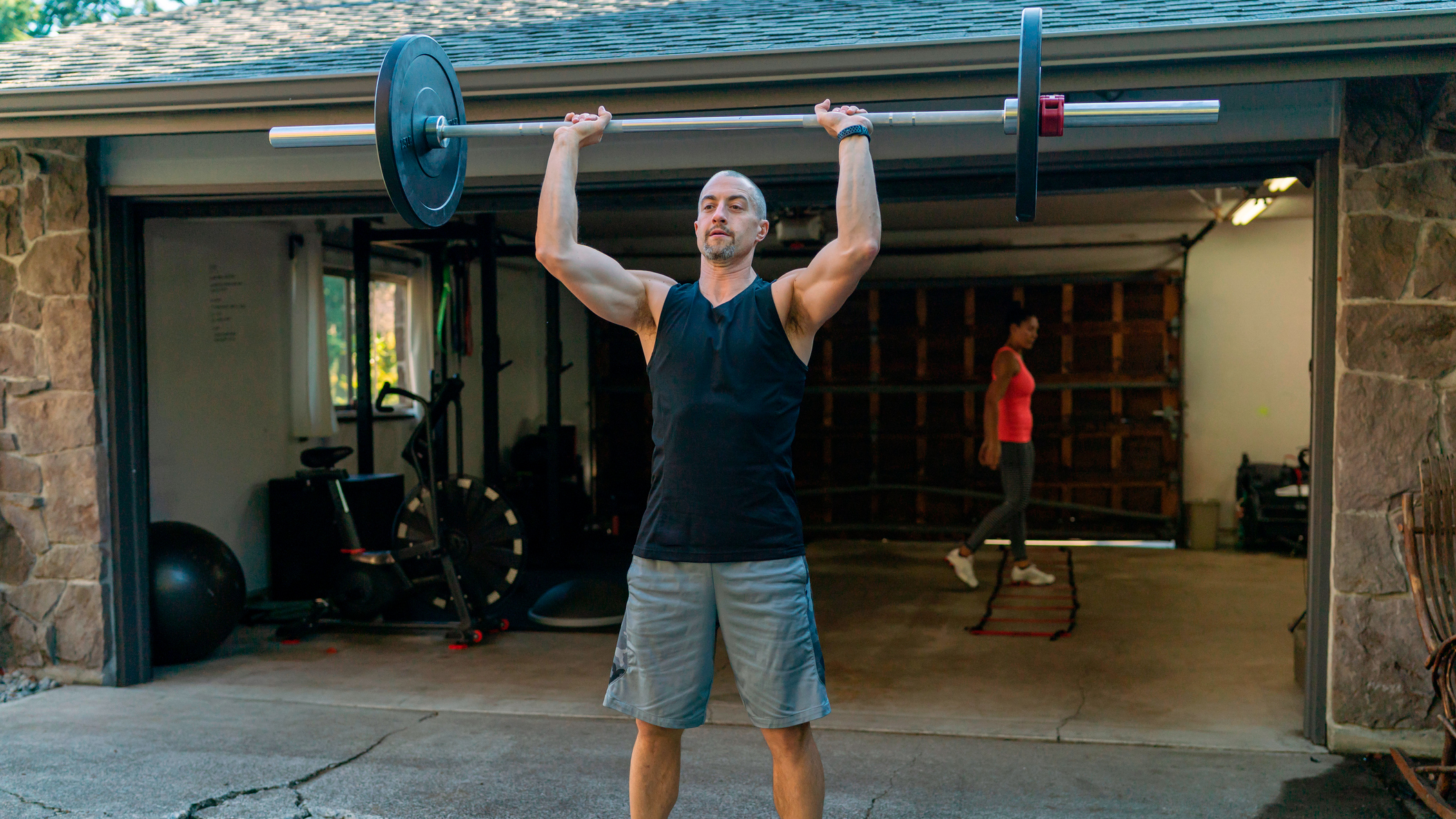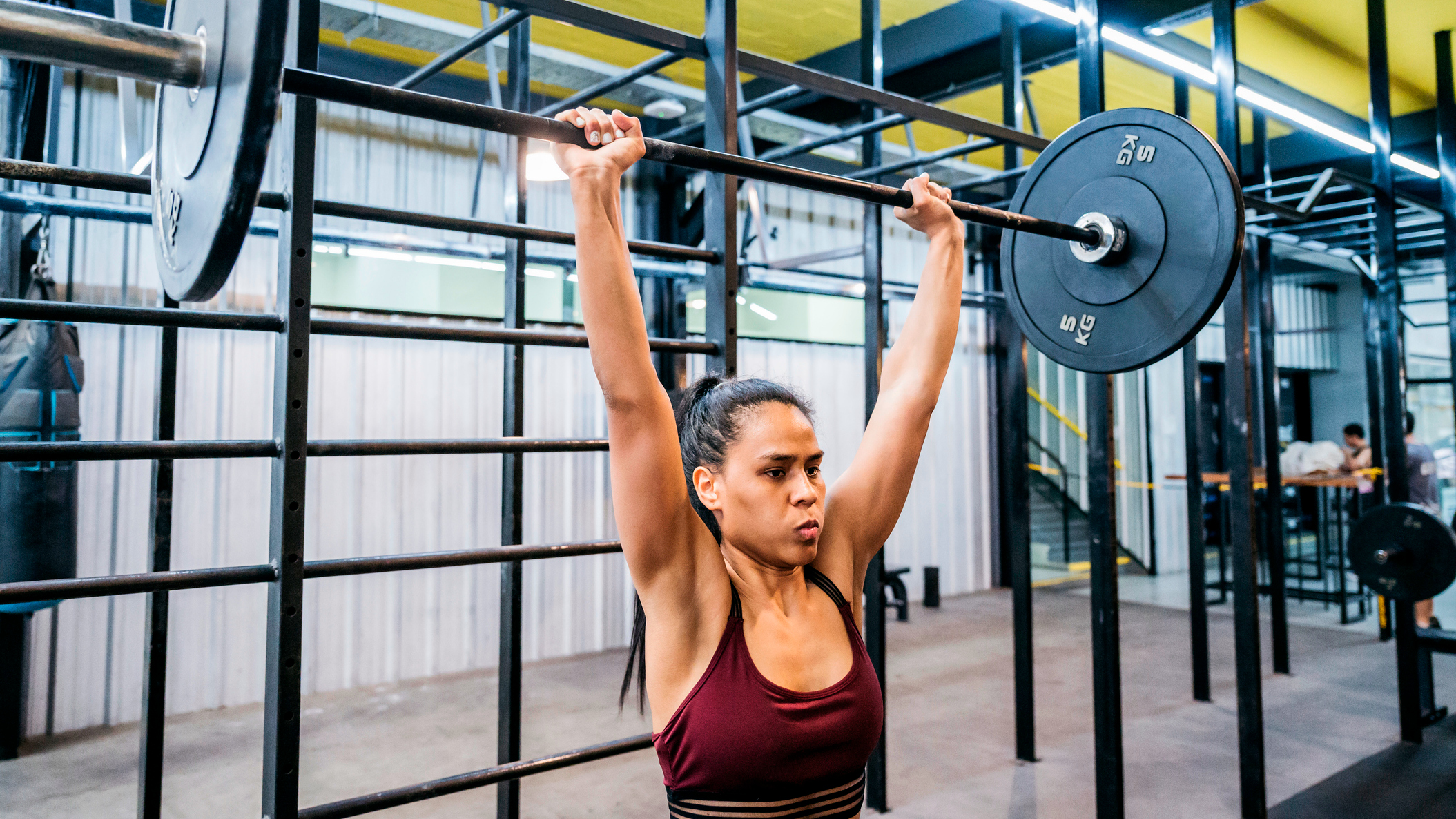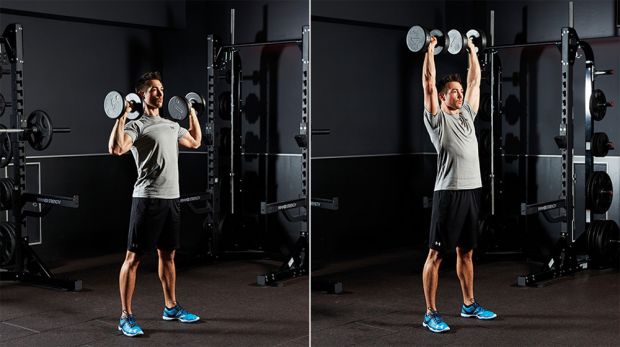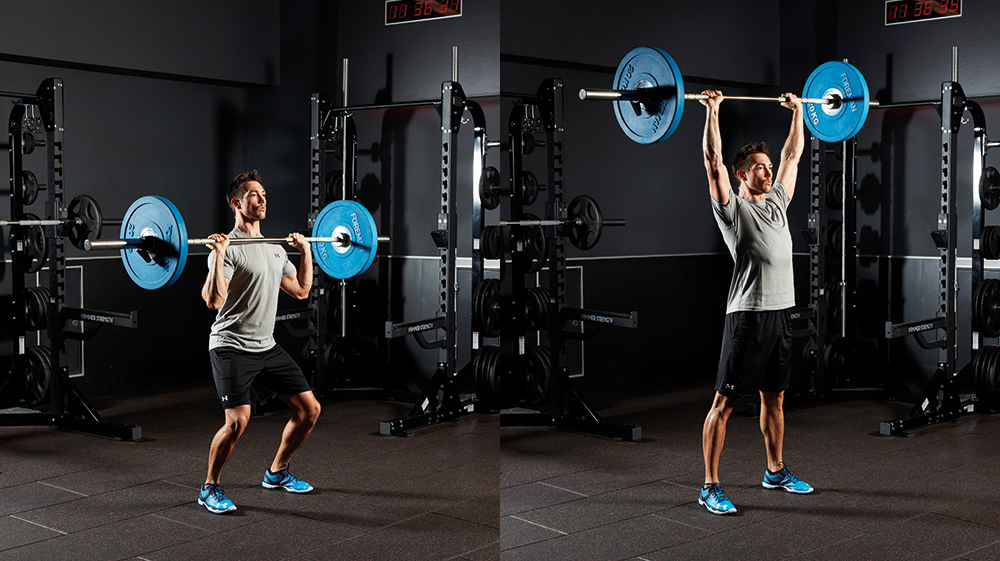How To Perfect The Overhead Press
Add size and strength to your shoulders—and work your upper body—with the overhead press

There are plenty of compelling fitness-related reasons to do the overhead press, but first let’s address the obvious: hoisting a heavy weight skywards looks incredibly impressive. However, that can be a downside too, leading some people to attempt the move when they’re not ready for it or use too heavy a weight in an effort to impress.
To help you ensure you’re not one of those people, we’ve sought out expert advice from Wahoo Sports Science’s expert strength coach Jeff Hoobler, who provided a straightforward test to see if you are shoulder mobility and core strength to pull it off. Hoobler also detailed how to perform the overhead press, along with assistance shoulder exercises that will help you build strength in the muscles used in the movement. We also dive into the benefits of adding it into your training plan. But first, let’s clear up a couple of common questions.
What’s the difference between the overhead press and shoulder press?
“It’s going to depend on who you ask, but I think it’s just a case of semantics,” says Hoobler. Some people may say the overhead press and shoulder press have subtle differences, but on the whole it’s accepted they are two different names for the same movement.
What muscles does the overhead press work?
The overhead press is often seen as a shoulder exercise, and it does hit all three heads of the shoulder (the anterior, lateral and posterior deltoid muscles). However, as a multi-joint compound exercise, it also recruits many of your body’s stabilizing muscles.
“It’s a standing, overhead move, so you’re loading the entire body,” says Hoobler. “And you have to be able to brace your midsection and maintain stability, making it a core exercise, too.
“But, looking at the active muscles, you have the anterior, lateral and posterior deltoids, the triceps and a little bit of chest. And then, obviously the lats are playing a part, but they’re more of a stabilizer.”
Benefits Of The Overhead Press

“I think the biggest reason to do this move is to load the entire body,” says Hoobler. “Any time you put a weight over your head, you’re doing that.
“You might be working the shoulders, but the corollary benefit is building core stability and building structural integrity throughout the entire kinetic chain [the system of muscles and joints used to perform a movement].”
Paired with the right nutrition, the overhead press can help build size and power in the active muscles (the delts, triceps and chest) while strengthening other stabilising muscles like the core and lats. And the pushing motion you’re training with this exercise has excellent transferability to sport-specific skills.
“This one’s a little more specific to sports like American football,” says Hoobler. “It depends on what position you're playing, but if you look at an offensive tackle, they’re pushing all the time, so the overhead press is a very key move.”
How To Work Up To The Overhead Press

The overhead press is a great barbell exercise for building strength and size in your shoulders, triceps and even chest, and you’ll find it featured in our favourite gym workout routines, upper-body workouts and shoulder workouts, but it’s not suitable for absolute beginners.
Sign up for workout ideas, training advice, reviews of the latest gear and more.
“It’s a good move but it’s not something that I would have a novice do,” says Hoobler. “I would start with dumbbells, the reason being that some people are very limited in their range of motion at the shoulder.”
Work on mastering the seated dumbbell shoulder press before you reach for your nearest barbell. Using dumbbells allows you to train a greater range of motion through the shoulder, and using an upright bench will provide stability, making it easier to maintain a neutral spine so you can concentrate on keeping tension through your shoulders when pressing the weight.
To check you’re ready to attempt the full overhead press, try Hoobler’s quick test below.
“The requirements for the overhead press are that you have good shoulder mobility, and that you can get both hands straight up over your head keeping a neutral spine. Being able to do this is not as common as we'd like to think.”
How To Do The Overhead Press
If you’ve passed the test above, it’s time to try the barbell overhead press.
“Your intention for this lift needs to be quality over quantity or load,” says Hoobler. “Timing is key, so pick a weight you can control. For most people, a one-count concentric [lifting] phase and a two or three-count eccentric [lowering] is a good place to start.”
“Start with the barbell in a rack at about chest height,” says Hoobler. “Step into the rack and hold the bar with an overhand grip.” Your hands should be just wider than shoulder-width apart. “Brace your core and drive your hands upwards to press it overhead, maintaining a neutral spine throughout.”
“Keep the bar close to your face as you press upwards, then control it on the way down rather than just letting it fall. It’s a simple lift, you’re just pressing a bar overhead, but it’s difficult to execute if you don’t have the core integrity.” This is why you need to keep your core tight throughout, providing a stable base from which to push from.
You should also keep your forearms vertical throughout the lift, and avoid flaring your elbows too far out to your side.
You might think the body should stay as still as possible during this exercise, but Hoobler says your torso will naturally move when performing the lift.
“The body does move, but it moves as a unit. As you press, your chest and head will move backward a bit—if you have poor mobility, your body will move more.
“I like to see people just clear their nose [with the bar], keeping the bar path as straight as possible.”
How To Perfect The Overhead Press
Use this advice from strength coach Andy McKenzie to master the movement.
Take a shoulder-width grip
“The wider apart your hands are on the bar, the weaker you will be and the less weight you will be able to lift. Aim for a grip with hands no wider than shoulder-width apart and keep your elbows directly underneath your wrists to keep you in the strongest mechanical position possible for the lift.”
Mobile wrists are key
“For the strongest press possible you need to have mobile wrists so that they can extend back towards your body,” says McKenzie. “The better the starting position of your wrists, the more able you are to initiate the move with a strong push.”
Squeeze your shoulder blades
“At the start of each rep focus on squeezing your shoulder blades together, then focus on using your shoulders to initiate the lift and get the bar moving. Lower the bar under control, ensuring that your shoulders are fully engaged and managing the weight with good form.”
Adjust your head position
“The bar starts across your upper chest below your chin, so your head must tilt backwards slightly as you push the bar up in the straightest line possible to avoid hitting your chin and nose. As you press the bar up, tilt your head backwards so that the bar just misses your nose on the way up.”
Keep your chest up
“You need to keep your chest up during each rep to maintain a strong and stable upper back, which in turn allows better and smoother movement patterns of all the muscles and joints involved in the lift – especially the shoulders, which are one of the most easily damaged joints in the body.”
Common Overhead Press Mistakes
Flaring your elbows: “It sounds odd when the lift is called the shoulder press but where you place your elbows when lifting makes all the difference,” says Scott Britton, CrossFit and powerlifting athlete as well as the co-founder of charitable fitness competition Battle Cancer. “Try to keep your elbows in front of you when lifting. When your elbows flare out to the sides during an overhead pressing move, this can lead to injury in your triceps and increase the risk of tendonitis.”
Incorrect breathing: “Make sure you take and hold a strong breath just before you press the weight,” says Britton. “Timing your breathing to each repetition will not only keep your body more stable but also help force more oxygen into your muscles to last longer.”
Thumbless grip: Use an overhand grip with your thumb wrapped under the bar to keep it secure. Some people place all five fingers over the bar, but Hoobler warns, “I’ve seen bad things happen when people do that, especially when you have sweaty hands.”
Lifting under fatigue: Lifting under muscular fatigue is a key element of strength and hypertrophy training, but it can lead to lazy form. “As you fatigue, it’s very common to use other muscles to assist your last few reps,” says Hoobler. “A lot of the time, you’ll see people get on their toes for that extra little pop of momentum [as seen in the push press].” Hoobler says this is OK to do if you’re consciously making the switch, just make sure you maintain a neutral spine.
Overhead Press Variations
Dumbbell overhead press

By using dumbbells you’ll work each side of the body unilaterally, which should ensure that you don’t have any strength imbalances. So even if you’re accomplished at the overhead press you should sub in dumbbells from time to time just to check that both sides are working equally when lifting the bar, rather than one doing the bulk of the work. The dumbbell press can also be beneficial for your joint health because it enlists smaller stabilising muscles to control the weight.
Hold a dumbbell in each hand at shoulder height with your palms facing forwards. Press the weight directly overhead, keeping your elbows below your wrists.
Military press

It’s sometimes confused with simply doing an overhead press with strict form, but the military press actually differs from the standard overhead press in that you bring your feet close together, in the manner of a soldier standing at attention. This means your glutes and core have to work extra hard during the exercise to maintain the stable base required for the lift. Since you’re losing a bit of your lower-body stability with this variation, it’s important to put less weight on the barbell than you would for a standard overhead press.
Push press

The push press allows you to recruit your lower body to help you press the weight overhead, so it’s a great variation for people struggling with the full overhead press. There’s also nothing wrong with switching to it halfway through a set of overhead presses if you become fatigued. Start with the bar on your upper chest, then drop into a quarter squat and drive back up, using the momentum to help you thrust the bar above you.
Thruster

The thruster is similar to a push press, but you lower into a full squat before driving back up and pressing the barbell overhead. It’s a winning combination of the front squat and the overhead press, creating an exercise that challenges muscles all over the body. With so many major muscle groups involved, the thruster also gets your heart pumping hard, making it a great addition to a HIIT workout. However, if you are doing it as part of a circuit, be mindful of your form. There’s no point in losing your shape just to fly through the reps quicker – you’ll risk injury and reduce the benefits of the move.
Kettlebell press

This variation is a good way to make sure that your movement patterns are on point when you press, because the way the kettlebell sits on the back of your wrists encourages you to lift it straight overhead rather than to the side or behind you and putting undue strain on your shoulders.
Hold a kettlebell at shoulder height with your elbow underneath your hand, then press it directly overhead, rotating your arm 90° so your palm is facing forwards at the top of the move.

Harry covers news, reviews and features for Coach, Fit&Well and Live Science. With over a decade of training experience, he has tried everything from powerlifting to gymnastics, cardio to CrossFit, all in a bid to find fun ways of building a healthy, functional body.
- Nick Harris-FrySenior writer
